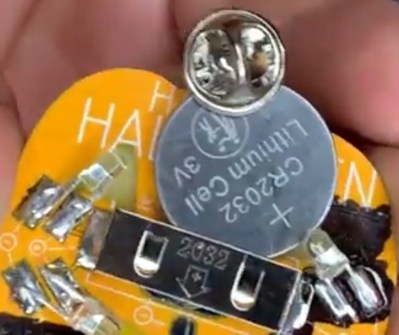Now first of all, [Steph] grants that you can already take your pick of several LED pumpkin badges out there on IO. That’s not the point. The point is that this flickering pumpkin pin is nicely-built as well as being open source.
 Even though it’s fully featured — it flickers, it’s wearable, and it’s lightweight — the build couldn’t be more simple. It’s fancy through-hole LEDs and a coin cell holder, plus a tack pin to stick it through your shirt. But the final result is quite elegant thanks to clever use of PCB layering.
Even though it’s fully featured — it flickers, it’s wearable, and it’s lightweight — the build couldn’t be more simple. It’s fancy through-hole LEDs and a coin cell holder, plus a tack pin to stick it through your shirt. But the final result is quite elegant thanks to clever use of PCB layering.
The first version was to get all the layers right to let the light through and embellish the jack-o-lantern’s lines with manufacturer-applied silver solder, but as [Steph] points out, it looked ‘like something a disturbed child might carve into their desk in detention’. So [Steph] enlisted [Mx. Jack Nelson], who improved the artwork.
Pretty much every component does double duty here, including the tack pin — it serves as a switch because it can hold the battery in place. The battery’s edges reflect the glowing light quite nicely around the edge of the pin. And the LEDs beneath the battery prevent it from slipping out. You can see how it goes together in the video after the break.
















Cute project for my nephew’s son. Parts list/source? Why do the LEDs need no current limiting (e.g. CR2032 doesn’t have enough power)?
yup, you see them in mini keychain flashlights like that too.
Hi Edmund! You can get the gerber files to make your own PCB from our hackaday page.
The board uses the footprint from this specific battery holder: https://www.sparkfun.com/products/11892
…but many types will fit on the same footprint. You can compare the pad distances with the datasheet linked from the Sparkfun page.
The 3mm flickering LEDs can be found from a variety of sources. However, they often come in quantities of 100. Here’s a tindie seller that offers a 10-pack:
https://www.tindie.com/products/terraintronics/10x-flickering-3mm-leds/
We also have kits available :)
As to your question about the CR2032 and current limiting, hackaday has a good article:
https://hackaday.com/2017/12/22/coin-cells-the-mythical-milliamp-hour/
CR2032’s have pretty high internal series resistance. Also the leds aren’t simple leds, there’s an onboard controller chip that modulates the flickering output (likely via pwm).
Add an option to make it an SAO.
What’s an SAO, in this context?
I’m not sure if the new comment system allows URLs without additional text, so I’m adding this useless sentence.
https://hackaday.io/project/175182-simple-add-ons-sao
More on flickering LEDs: https://hackaday.com/2013/12/16/reverse-engineering-a-candle-flicker-led/
@sjm4306 said: “Also the leds aren’t simple leds, there’s an onboard controller chip that modulates the flickering output (likely via pwm).”
The Hackaday comment system won’t let me reply, so I’ll just drop this here…
Often the onboard controller chip in the flickering candle LED is playing a simple melody like “Happy birthday to you…” via Pulse-Width-Modulation (PWM). The PWM song appears as pseudo-random, hence the visible flicker. These PWM song LEDs are often used in novelty greeting cards. When you open the card a contact closes powering on the LED which then plays the PWM song which you can hear via a piezoelectric sound transducer which also acts as a low pass filter which acts as a PWM demodulator. You should be able to hear the song by putting a sound transducer across the flickering LED (with an appropriate series current-limit resistor, if needed of-course).
If the flickering LED is not playing a PWM song, it is probably just sending a pseudo-random bit-stream from a Linear-Feedback-Shift-Register (LFSR).[1]
* Reference:
1. Linear-Feedback-Shift-Register (LFSR)
https://en.wikipedia.org/wiki/Linear-feedback_shift_register